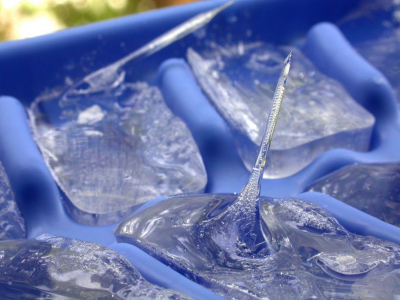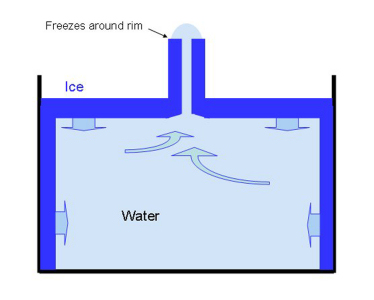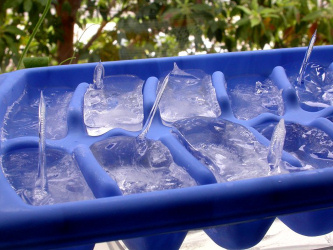|
|
 Ice
spikes are odd ice structures that occasionally grow out of ice cube
trays. Unlike some of the strange things you might find growing
in your refrigerator, ice spikes are made of nothing but ice. Ice
spikes are the result of physics, not biology. Ice
spikes are odd ice structures that occasionally grow out of ice cube
trays. Unlike some of the strange things you might find growing
in your refrigerator, ice spikes are made of nothing but ice. Ice
spikes are the result of physics, not biology.
At
left are some pictures I took of ice spikes that grew in my kitchen
freezer. They look a lot like the limestone stalagmites found in
caves, although there was no water dripping inside my freezer when
these formed.
To see your own ice spikes, make ice cubes in an ordinary plastic ice cube tray, in an ordinary household freezer, but using distilled water,
which you can buy in most supermarkets for about a dollar a
gallon. We've tried several different freezers, and almost always
got some ice spikes to grow. |
|  Ice
spikes grow as the water in an ice cube tray turns to ice. The
water first freezes on the top surface, around the edges of what will
become the ice cube. The ice slowly freezes in from the edges,
until just a small hole is left unfrozen in the surface. At the
same time, while the surface is freezing, more ice starts to form
around the sides of the cube. Ice
spikes grow as the water in an ice cube tray turns to ice. The
water first freezes on the top surface, around the edges of what will
become the ice cube. The ice slowly freezes in from the edges,
until just a small hole is left unfrozen in the surface. At the
same time, while the surface is freezing, more ice starts to form
around the sides of the cube.
Since
ice expands as it freezes, the ice freezing below the surface starts to
push water up through the hole in the surface ice (see diagram).
If the conditions are just right, then water will be forced out of the
hole in the ice and it will freeze into an ice spike, a bit like lava
pouring out of a hole in the ground to makes a volcano. But water
does not flow down the sides of a thin spike, so in that way it is
different from a volcano. Rather, the water freezes around the
rim of the tube, and thus adds to its length. The spike can
continue growing taller until all the water freezes, cutting off the
supply, or until the tube freezes shut. The tallest spike we've
seen growing in an ordinary ice cube tray was 56mm (2.2in) long.
|
|  Most
ice cube trays produce a few spikes, but usually only if distilled
water is used. Millions of people make ice cubes every day using
ordinary tap water, and most don't see ice spikes. Oddly enough,
some people often get plenty of ice spikes using ordinary tap water,
but this appears to be rare. Most
ice cube trays produce a few spikes, but usually only if distilled
water is used. Millions of people make ice cubes every day using
ordinary tap water, and most don't see ice spikes. Oddly enough,
some people often get plenty of ice spikes using ordinary tap water,
but this appears to be rare.
|
| If you want to read more about the mysterious ice spikes, here are some articles on the subject:
An exploratory study of ice-cube spikes, by C. A. Knight, Journal of Glaciology (2005)
Experiments on ice spikes and a simple growth model, by L. Hill, E. Lozowski, and R. D. Sampson, Journal of Glaciology (2004)
An investigation of laboratory-grown ice spikes, by K. G. Libbrecht and K. Lui, Journal of Glaciology (2004) | |
|
|
|
